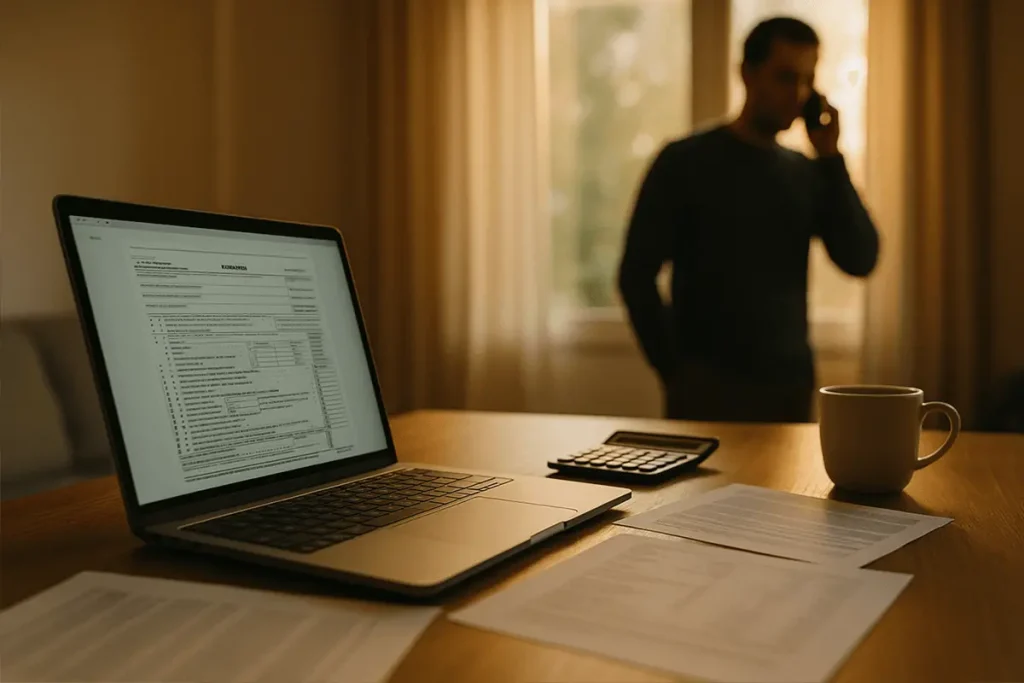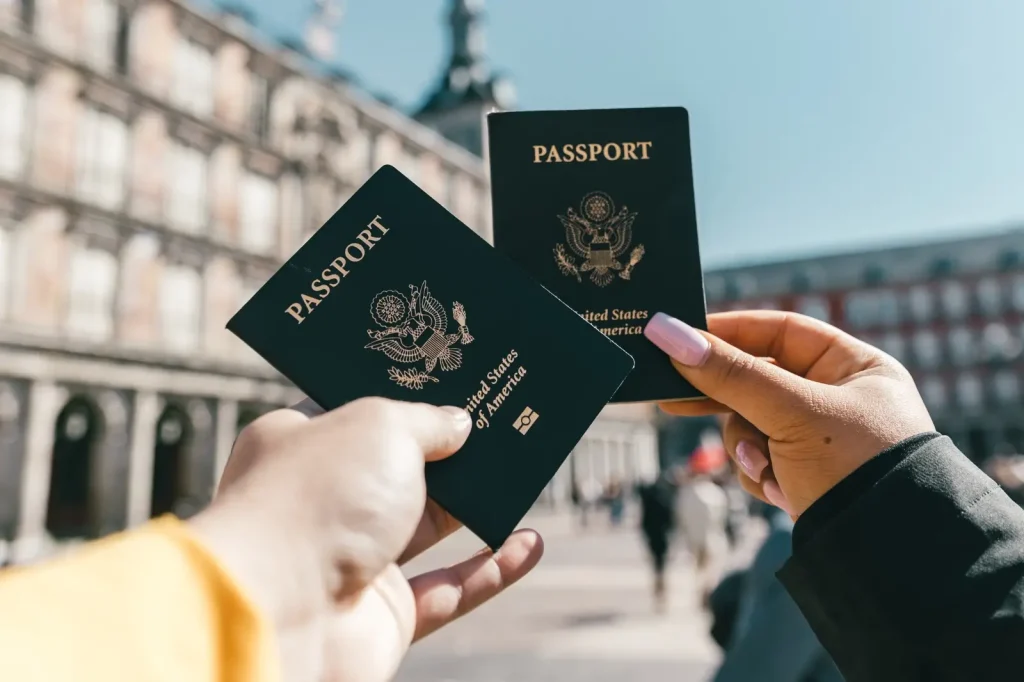
The K-1 Fiancé Visa in the US: What It Is and How to Apply
July 22, 2025
Adjustment of Status vs. Consular Processing: Which Is Right for You?
August 20, 2025
The K-1 Fiancé Visa in the US: What It Is and How to Apply
July 22, 2025
Adjustment of Status vs. Consular Processing: Which Is Right for You?
August 20, 2025
Immigrant Visa for U.S. Citizen Spouses: Common Denial Reasons Explained
Get smart tips to sidestep the mistakes that slow down or derail marriage-based green card applications
If you're navigating the marriage-based immigration process—whether applying for an immigrant visa abroad or adjusting status to get your green card in the U.S.—you're probably doing everything you can to get it right. And sometimes? That pressure can feel overwhelming.
While having a trusted immigration attorney is one of the most important steps you can take, it also helps to understand where things most often go wrong during the marriage-based green card application process.
In this article, we explain the most common reasons spousal visa applications get denied—and how to avoid them. These tips won't replace smart legal advice, but they'll help you feel more informed and prepared for what's ahead.
Understanding the Basic Process to Bring Your Spouse to the U.S.
When you apply for permanent residency through marriage, the U.S. citizen spouse and foreign spouse must apply together through a coordinated process. The U.S. citizen spouse for at least the initial petition (Form I-130) takes the lead in establishing the relationship, while the foreign spouse must submit additional forms and documentation.
This process allows the foreign spouse to obtain lawful permanent resident status, though spousal visa processing times can vary significantly depending on your specific situation and the current USCIS workload. Understanding this framework helps you see where potential problems might arise.
At the end of this post, you'll find a glossary of terms that can be helpful if you’re new to the spousal immigration or fiance visa process!

Now, let's look at the most common reasons these spousal immigrant visa applications get denied:
1. Insufficient Evidence of a Bona Fide Marriage During Visa Applications
USCIS looks for more than just a marriage certificate. They want to see proof that your relationship is genuine and ongoing. If your application lacks evidence of a real marriage—like shared bank accounts, joint leases, insurance policies listing each other as beneficiaries, or a collection of photos spanning your relationship—it could be denied.
Many couples submit minimal documentation, thinking their marriage certificate speaks for itself. It doesn't. USCIS officers review thousands of applications and need concrete evidence that your marriage isn't just for immigration benefits. Communication records, travel receipts from trips together, and witness statements from family and friends all help paint a picture of your genuine relationship.
The key is variety and consistency. Don't just submit bank statements from one month or photos from your wedding day. Show the evolution of your relationship through different types of evidence spanning multiple time periods.
2. Missing or Incomplete Forms During the Visa Application Process
Even small errors on forms like I-130 or I-485 can lead to delays or denials. Missing signatures, incorrect dates, or skipped questions are surprisingly common mistakes that can derail your entire application. USCIS doesn't give you partial credit for mostly complete forms.
Every field matters. If a question doesn't apply to you, write "N/A" rather than leaving it blank. Double-check that all dates match across forms and supporting documents. Make sure signatures are in the right places and that you've included all required supporting materials.
Having everything reviewed by an experienced immigration attorney can save you months of waiting for corrections or, worse, starting over entirely. What seems like a minor oversight to you might be a major red flag to USCIS.

3. Mistimed Filings or Filing for a U.S. Spousal Visa Too Soon After Entry
Timing matters more than you might think. If you apply for a green card too soon after entering the U.S. on a different visa, it may raise concerns about "immigrant intent." This is especially risky with tourist visas, where the assumption is that you plan to return home.
USCIS looks for patterns that suggest you entered the country with the secret intention of staying permanently. Getting married days after arriving on a tourist visa and immediately filing for a green card sends up red flags. Even if your love story is genuine, the optics can work against you.
Our immigration attorneys can help you navigate these timing considerations and avoid actions that might look like visa fraud. Sometimes waiting a few months makes all the difference between approval and denial.
4. Inconsistent or Conflicting Information on your Visa Petition
Discrepancies between forms, interviews, or documents can sink your application faster than almost anything else. Mismatched addresses, conflicting timelines about when you met or got married, or different versions of your story between spouses create doubt about your credibility.
USCIS officers are trained to spot inconsistencies, and they take them seriously. If your I-130 says you met in January but your interview responses suggest it was March, expect follow-up questions. If your spouse lists a different address history than you do, it raises concerns.
Before submitting anything, review all forms together. Make sure you're both telling the same story with the same details. Create a timeline of your relationship that you both understand and can speak to confidently during your interview.

5. Criminal History or Immigration Violations Discovered During the Visa Process
A past criminal record or immigration violation doesn't automatically mean denial, but it does complicate your case significantly. Many people think they can hide past issues or that minor infractions don't matter. This approach almost always backfires.
USCIS has access to extensive databases and background check systems. They will find out about arrests, convictions, overstays, and other violations. When they discover information you didn't disclose, it raises serious questions about your honesty and character.
Waivers may be available for certain violations, but your attorney needs to know everything to develop the right strategy. Being upfront about past issues allows your legal team to address them proactively rather than defensively.
6. Inadequate Financial Sponsorship to Enter the United States on an Immigrant Visa
The U.S. citizen or green card holder must prove they can financially support their spouse without relying on government benefits. This requirement involves specific income thresholds and detailed documentation through the Affidavit of Support (Form I-864).
If your income doesn't meet the required threshold—125% of the federal poverty guidelines for your household size—or if your I-864 is incomplete or poorly documented, your case could be denied. Tax returns, pay stubs, employment letters, and bank statements all need to align and tell a consistent story about your financial stability.
Sometimes a joint sponsor is necessary. This might be a family member who meets the income requirements and is willing to take on the legal obligation to support your spouse. Don't wait until after filing to figure out your financial sponsorship strategy.

7. Poor Interview Preparation with your Spouse
The green card interview is your chance to demonstrate that your marriage is genuine, but it's also where many couples stumble. Nervous answers, inconsistent stories, or vague responses about basic details of your relationship can work against you.
Officers ask detailed questions about your daily routines, your home, your spouse's work schedule, and other intimate details of married life. If you can't answer basic questions about each other or if your answers don't align, it raises red flags about the authenticity of your relationship.
Preparation makes a significant difference. Review your relationship timeline, practice answering common questions together, and understand what documents you might need to bring.
8. Failure to Respond to Requests for Evidence During the Processing Time
USCIS may request additional evidence (RFE) or issue a Notice of Intent to Deny (NOID) if they need clarification or more documentation. These requests have strict deadlines, and failing to respond—or submitting inadequate materials—often results in automatic denial.
Many people panic when they receive these notices and either rush to respond without proper preparation or assume their case is hopeless. Neither approach serves you well. RFEs and NOIDs are opportunities to strengthen your case by providing exactly what USCIS needs to approve your application.
Legal guidance for immigration purposes ensures your response addresses the specific concerns raised and provides compelling evidence to overcome any doubts about your case.

9. Issues with Prior Marriage Documentation During Green Card Process
If either spouse was previously married, USCIS requires proof that those marriages legally ended before your current marriage began. Missing divorce decrees, improperly translated foreign documents, or confusing timelines about previous relationships can cause significant delays or denials.
Gather all documentation early in the process. If you were married abroad or your divorce occurred in another country, you'll likely need certified translations and additional authentication. Don't assume that documents in your possession are sufficient—USCIS has specific requirements for what they'll accept as proof.
Complex marriage histories require careful documentation and sometimes additional legal analysis to ensure everything meets USCIS standards. You can always view the USCIS website for more on the immigrant visa petition requirements.
10. Filing CR1 and IR1 Visas Without Experienced Legal Help
One of the most common reasons for denial is attempting to navigate the spousal visa process alone. Immigration law involves complex regulations, strict deadlines, and detailed requirements that change regularly. A small mistake can cost you significant time, money, and emotional stress, and make it difficult to come to the United States to live.
Ready to move forward? Once you understand these common denial reasons, the actual filing process becomes clearer. You'll start by filing the petition for alien relatives (Form I-130), which establishes your qualifying relationship. This petition determines which visa categories apply to your situation.
Choosing your path: After I-130 approval, you'll file form I-485 for Adjustment of Status if your spouse is already in the U.S., or proceed with consular processing if they're abroad. Each path has different requirements and timelines, but both lead to the same goal.
The finish line: Whether through adjustment or consular processing, success means your spouse receives their permanent resident card and can live and work freely in the United States. The key is avoiding the denial reasons we've covered and working with experienced legal counsel to navigate the process strategically.

Don't Leave Your Future to Chance
There's no one-size-fits-all approach to an immigrant visa application. Every couple's story is different, and so is every case. The immigration process involves real legal complexities that require careful attention to detail and strategic thinking.
At Strang Immigration, we understand the stakes involved in your application for an immigrant visa for a spouse. Our approach combines legal expertise with clear communication to help you navigate this process successfully. We don't tell you what you want to hear—we provide honest, accurate guidance tailored to your specific situation, so that you can live in the United States legally.
If you're ready to take the next step with confidence, we're here to help.
Contact us today to schedule a consultation and discover how our experienced team can help you avoid these common pitfalls and achieve a successful marriage-based visa outcome.
Helpful Spousal Visa US Terms:
Immigrant Visa (CR1 and IR1 Type of Visa):
The CR1 visa and IR1 visa are issued abroad, allowing entry to the U.S. as a lawful permanent resident. The CR1 immigration visa is for marriages under two years, and the IR1 visa is for marriages lasting longer. The foreign spouse must apply when they are outside the U.S.
Green Card:
The official document proving permanent resident status in the U.S., obtained either through an immigrant visa or by applying for Adjustment of Status within the United States.
Adjustment of Status:
The process of applying for a green card while physically present in the U.S., typically using Form I-485. Once you legally come to the United States on your immigrant visa, you can apply for your marriage green card.
Form I-130:
The petition filed by a U.S. citizen or permanent resident; this establishes the qualifying relationship with the foreign spouse of a U.S. citizen to begin the immigration process.
Affidavit of Support (Form I-864):
A legal promise made by the sponsor to United States citizenship and immigration services (and U.S. government) to financially support their spouse, demonstrating they meet income requirements.
Request for Evidence (RFE):
A formal notice from USCIS requesting more documents or information to continue processing a spouse visa application.
Bona Fide Marriage:
A marriage entered into in good faith and not solely for immigration benefits. This is crucial if you live in the United States and want to bring your spouse on a CR1 or IR1 visa.
ABOUT US

We are dedicated to protecting your legal rights at every stage of the process. Discover for yourself how our immigration attorneys can help you obtain a successful outcome



